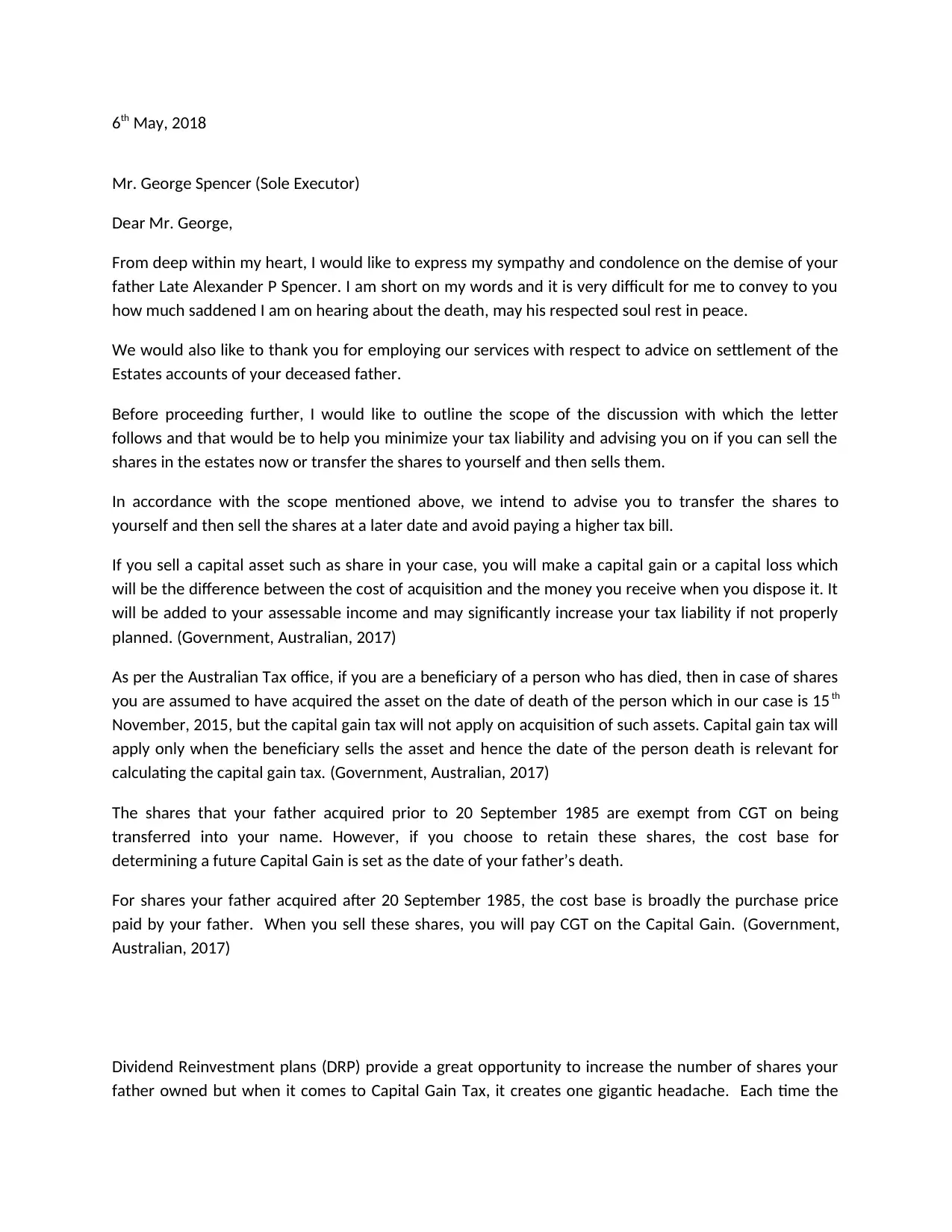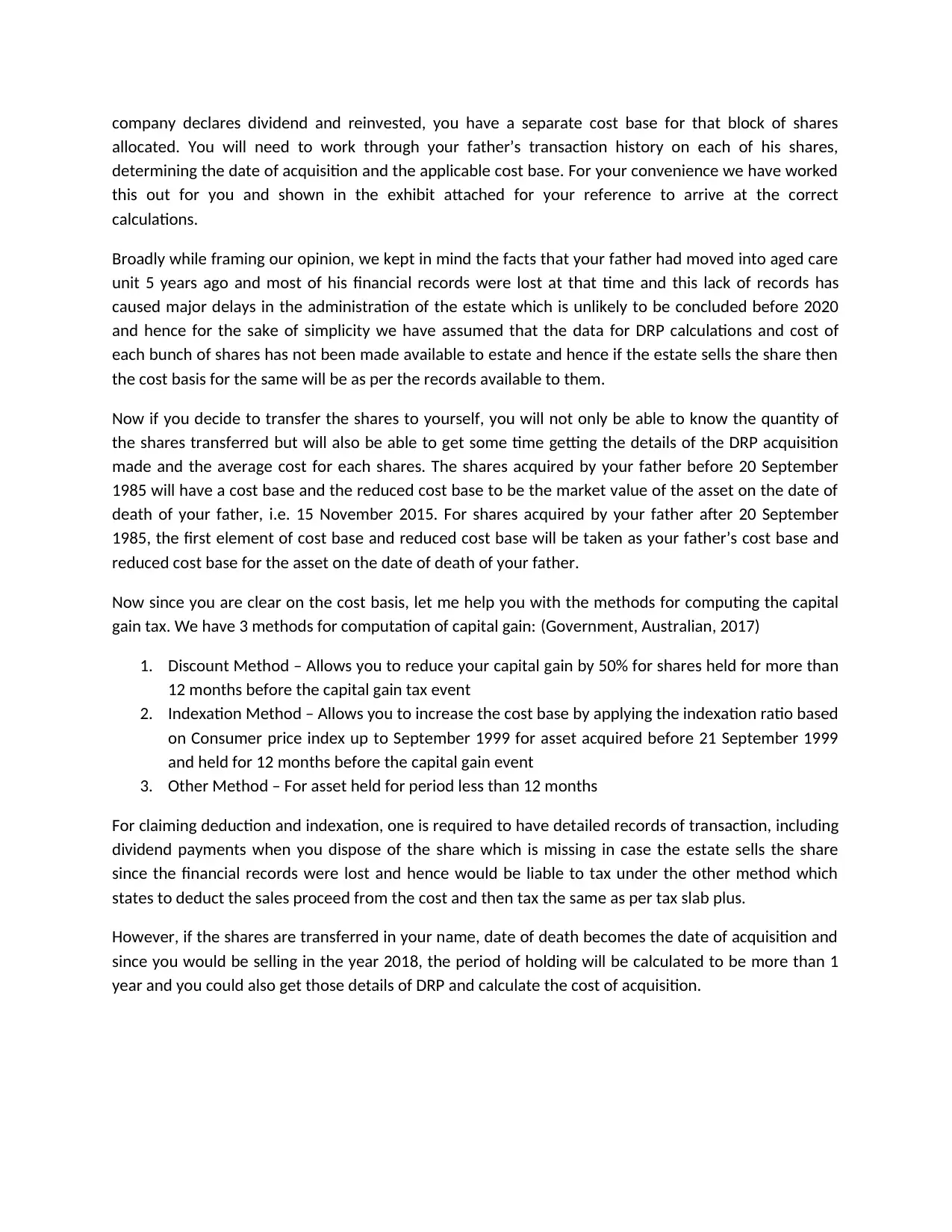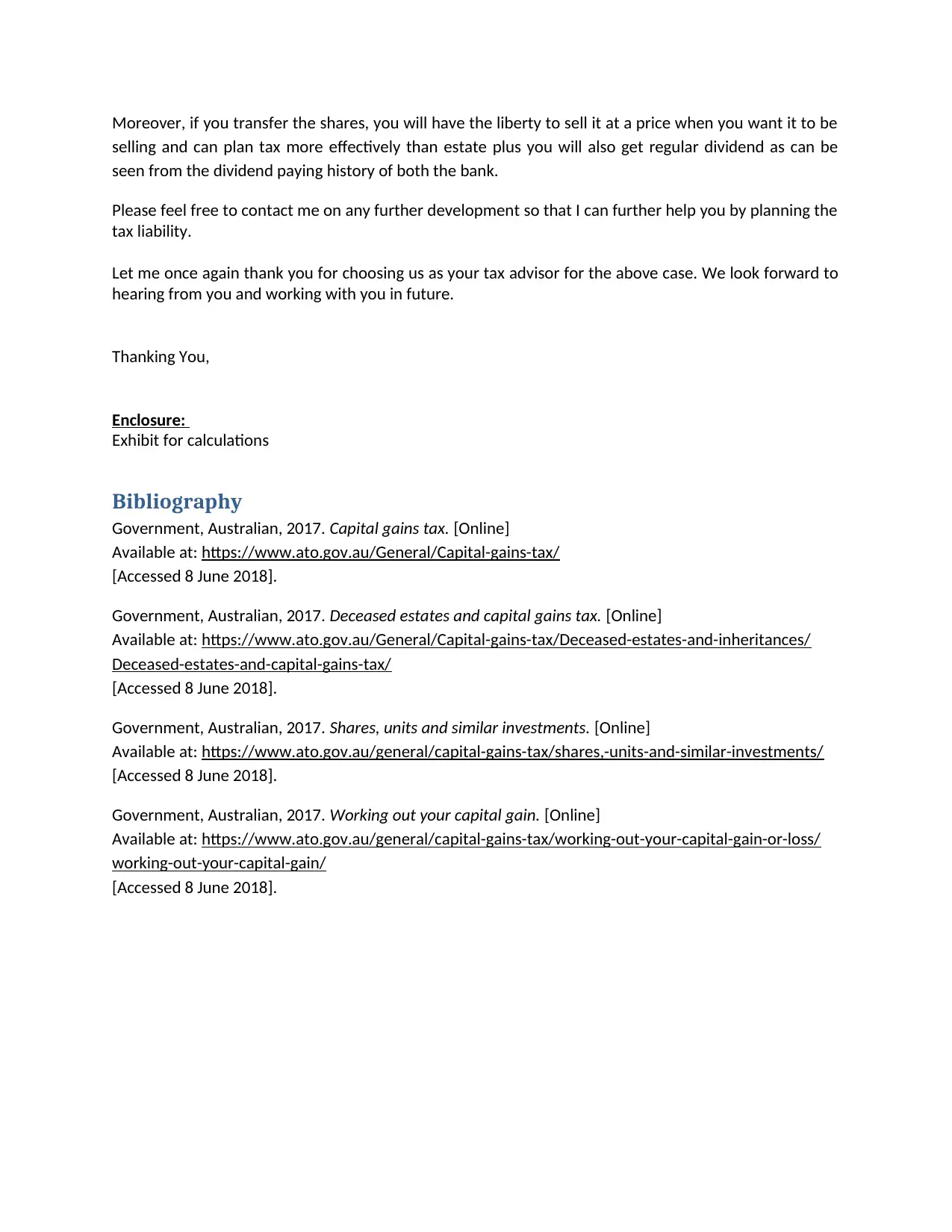Tax Planning for Deceased Estates: Share Transfer vs. Sale Analysis
VerifiedAdded on 2023/06/11
|3
|1321
|209
Report
AI Summary
This report provides advice on minimizing capital gains tax (CGT) liability related to the estate of the late Alexander P Spencer. It discusses whether to sell shares directly from the estate or transfer them to the beneficiary, Mr. George Spencer, before selling. The report recommends transferring the shares to Mr. Spencer to allow for better tax planning, including leveraging discount and indexation methods for CGT calculation. It also highlights the complexities of Dividend Reinvestment Plans (DRP) and the importance of detailed transaction records. The analysis considers that some financial records were lost, impacting the estate's ability to accurately determine the cost basis of the shares. Transferring the shares allows Mr. Spencer time to gather necessary details and potentially reduce his tax burden, also offering flexibility in choosing when to sell and benefit from dividends. The report references Australian Tax Office guidelines and provides an exhibit for calculations.

6th May, 2018
Mr. George Spencer (Sole Executor)
Dear Mr. George,
From deep within my heart, I would like to express my sympathy and condolence on the demise of your
father Late Alexander P Spencer. I am short on my words and it is very difficult for me to convey to you
how much saddened I am on hearing about the death, may his respected soul rest in peace.
We would also like to thank you for employing our services with respect to advice on settlement of the
Estates accounts of your deceased father.
Before proceeding further, I would like to outline the scope of the discussion with which the letter
follows and that would be to help you minimize your tax liability and advising you on if you can sell the
shares in the estates now or transfer the shares to yourself and then sells them.
In accordance with the scope mentioned above, we intend to advise you to transfer the shares to
yourself and then sell the shares at a later date and avoid paying a higher tax bill.
If you sell a capital asset such as share in your case, you will make a capital gain or a capital loss which
will be the difference between the cost of acquisition and the money you receive when you dispose it. It
will be added to your assessable income and may significantly increase your tax liability if not properly
planned. (Government, Australian, 2017)
As per the Australian Tax office, if you are a beneficiary of a person who has died, then in case of shares
you are assumed to have acquired the asset on the date of death of the person which in our case is 15 th
November, 2015, but the capital gain tax will not apply on acquisition of such assets. Capital gain tax will
apply only when the beneficiary sells the asset and hence the date of the person death is relevant for
calculating the capital gain tax. (Government, Australian, 2017)
The shares that your father acquired prior to 20 September 1985 are exempt from CGT on being
transferred into your name. However, if you choose to retain these shares, the cost base for
determining a future Capital Gain is set as the date of your father’s death.
For shares your father acquired after 20 September 1985, the cost base is broadly the purchase price
paid by your father. When you sell these shares, you will pay CGT on the Capital Gain. (Government,
Australian, 2017)
Dividend Reinvestment plans (DRP) provide a great opportunity to increase the number of shares your
father owned but when it comes to Capital Gain Tax, it creates one gigantic headache. Each time the
Mr. George Spencer (Sole Executor)
Dear Mr. George,
From deep within my heart, I would like to express my sympathy and condolence on the demise of your
father Late Alexander P Spencer. I am short on my words and it is very difficult for me to convey to you
how much saddened I am on hearing about the death, may his respected soul rest in peace.
We would also like to thank you for employing our services with respect to advice on settlement of the
Estates accounts of your deceased father.
Before proceeding further, I would like to outline the scope of the discussion with which the letter
follows and that would be to help you minimize your tax liability and advising you on if you can sell the
shares in the estates now or transfer the shares to yourself and then sells them.
In accordance with the scope mentioned above, we intend to advise you to transfer the shares to
yourself and then sell the shares at a later date and avoid paying a higher tax bill.
If you sell a capital asset such as share in your case, you will make a capital gain or a capital loss which
will be the difference between the cost of acquisition and the money you receive when you dispose it. It
will be added to your assessable income and may significantly increase your tax liability if not properly
planned. (Government, Australian, 2017)
As per the Australian Tax office, if you are a beneficiary of a person who has died, then in case of shares
you are assumed to have acquired the asset on the date of death of the person which in our case is 15 th
November, 2015, but the capital gain tax will not apply on acquisition of such assets. Capital gain tax will
apply only when the beneficiary sells the asset and hence the date of the person death is relevant for
calculating the capital gain tax. (Government, Australian, 2017)
The shares that your father acquired prior to 20 September 1985 are exempt from CGT on being
transferred into your name. However, if you choose to retain these shares, the cost base for
determining a future Capital Gain is set as the date of your father’s death.
For shares your father acquired after 20 September 1985, the cost base is broadly the purchase price
paid by your father. When you sell these shares, you will pay CGT on the Capital Gain. (Government,
Australian, 2017)
Dividend Reinvestment plans (DRP) provide a great opportunity to increase the number of shares your
father owned but when it comes to Capital Gain Tax, it creates one gigantic headache. Each time the
Paraphrase This Document
Need a fresh take? Get an instant paraphrase of this document with our AI Paraphraser

company declares dividend and reinvested, you have a separate cost base for that block of shares
allocated. You will need to work through your father’s transaction history on each of his shares,
determining the date of acquisition and the applicable cost base. For your convenience we have worked
this out for you and shown in the exhibit attached for your reference to arrive at the correct
calculations.
Broadly while framing our opinion, we kept in mind the facts that your father had moved into aged care
unit 5 years ago and most of his financial records were lost at that time and this lack of records has
caused major delays in the administration of the estate which is unlikely to be concluded before 2020
and hence for the sake of simplicity we have assumed that the data for DRP calculations and cost of
each bunch of shares has not been made available to estate and hence if the estate sells the share then
the cost basis for the same will be as per the records available to them.
Now if you decide to transfer the shares to yourself, you will not only be able to know the quantity of
the shares transferred but will also be able to get some time getting the details of the DRP acquisition
made and the average cost for each shares. The shares acquired by your father before 20 September
1985 will have a cost base and the reduced cost base to be the market value of the asset on the date of
death of your father, i.e. 15 November 2015. For shares acquired by your father after 20 September
1985, the first element of cost base and reduced cost base will be taken as your father’s cost base and
reduced cost base for the asset on the date of death of your father.
Now since you are clear on the cost basis, let me help you with the methods for computing the capital
gain tax. We have 3 methods for computation of capital gain: (Government, Australian, 2017)
1. Discount Method – Allows you to reduce your capital gain by 50% for shares held for more than
12 months before the capital gain tax event
2. Indexation Method – Allows you to increase the cost base by applying the indexation ratio based
on Consumer price index up to September 1999 for asset acquired before 21 September 1999
and held for 12 months before the capital gain event
3. Other Method – For asset held for period less than 12 months
For claiming deduction and indexation, one is required to have detailed records of transaction, including
dividend payments when you dispose of the share which is missing in case the estate sells the share
since the financial records were lost and hence would be liable to tax under the other method which
states to deduct the sales proceed from the cost and then tax the same as per tax slab plus.
However, if the shares are transferred in your name, date of death becomes the date of acquisition and
since you would be selling in the year 2018, the period of holding will be calculated to be more than 1
year and you could also get those details of DRP and calculate the cost of acquisition.
allocated. You will need to work through your father’s transaction history on each of his shares,
determining the date of acquisition and the applicable cost base. For your convenience we have worked
this out for you and shown in the exhibit attached for your reference to arrive at the correct
calculations.
Broadly while framing our opinion, we kept in mind the facts that your father had moved into aged care
unit 5 years ago and most of his financial records were lost at that time and this lack of records has
caused major delays in the administration of the estate which is unlikely to be concluded before 2020
and hence for the sake of simplicity we have assumed that the data for DRP calculations and cost of
each bunch of shares has not been made available to estate and hence if the estate sells the share then
the cost basis for the same will be as per the records available to them.
Now if you decide to transfer the shares to yourself, you will not only be able to know the quantity of
the shares transferred but will also be able to get some time getting the details of the DRP acquisition
made and the average cost for each shares. The shares acquired by your father before 20 September
1985 will have a cost base and the reduced cost base to be the market value of the asset on the date of
death of your father, i.e. 15 November 2015. For shares acquired by your father after 20 September
1985, the first element of cost base and reduced cost base will be taken as your father’s cost base and
reduced cost base for the asset on the date of death of your father.
Now since you are clear on the cost basis, let me help you with the methods for computing the capital
gain tax. We have 3 methods for computation of capital gain: (Government, Australian, 2017)
1. Discount Method – Allows you to reduce your capital gain by 50% for shares held for more than
12 months before the capital gain tax event
2. Indexation Method – Allows you to increase the cost base by applying the indexation ratio based
on Consumer price index up to September 1999 for asset acquired before 21 September 1999
and held for 12 months before the capital gain event
3. Other Method – For asset held for period less than 12 months
For claiming deduction and indexation, one is required to have detailed records of transaction, including
dividend payments when you dispose of the share which is missing in case the estate sells the share
since the financial records were lost and hence would be liable to tax under the other method which
states to deduct the sales proceed from the cost and then tax the same as per tax slab plus.
However, if the shares are transferred in your name, date of death becomes the date of acquisition and
since you would be selling in the year 2018, the period of holding will be calculated to be more than 1
year and you could also get those details of DRP and calculate the cost of acquisition.

Moreover, if you transfer the shares, you will have the liberty to sell it at a price when you want it to be
selling and can plan tax more effectively than estate plus you will also get regular dividend as can be
seen from the dividend paying history of both the bank.
Please feel free to contact me on any further development so that I can further help you by planning the
tax liability.
Let me once again thank you for choosing us as your tax advisor for the above case. We look forward to
hearing from you and working with you in future.
Thanking You,
Enclosure:
Exhibit for calculations
Bibliography
Government, Australian, 2017. Capital gains tax. [Online]
Available at: https://www.ato.gov.au/General/Capital-gains-tax/
[Accessed 8 June 2018].
Government, Australian, 2017. Deceased estates and capital gains tax. [Online]
Available at: https://www.ato.gov.au/General/Capital-gains-tax/Deceased-estates-and-inheritances/
Deceased-estates-and-capital-gains-tax/
[Accessed 8 June 2018].
Government, Australian, 2017. Shares, units and similar investments. [Online]
Available at: https://www.ato.gov.au/general/capital-gains-tax/shares,-units-and-similar-investments/
[Accessed 8 June 2018].
Government, Australian, 2017. Working out your capital gain. [Online]
Available at: https://www.ato.gov.au/general/capital-gains-tax/working-out-your-capital-gain-or-loss/
working-out-your-capital-gain/
[Accessed 8 June 2018].
selling and can plan tax more effectively than estate plus you will also get regular dividend as can be
seen from the dividend paying history of both the bank.
Please feel free to contact me on any further development so that I can further help you by planning the
tax liability.
Let me once again thank you for choosing us as your tax advisor for the above case. We look forward to
hearing from you and working with you in future.
Thanking You,
Enclosure:
Exhibit for calculations
Bibliography
Government, Australian, 2017. Capital gains tax. [Online]
Available at: https://www.ato.gov.au/General/Capital-gains-tax/
[Accessed 8 June 2018].
Government, Australian, 2017. Deceased estates and capital gains tax. [Online]
Available at: https://www.ato.gov.au/General/Capital-gains-tax/Deceased-estates-and-inheritances/
Deceased-estates-and-capital-gains-tax/
[Accessed 8 June 2018].
Government, Australian, 2017. Shares, units and similar investments. [Online]
Available at: https://www.ato.gov.au/general/capital-gains-tax/shares,-units-and-similar-investments/
[Accessed 8 June 2018].
Government, Australian, 2017. Working out your capital gain. [Online]
Available at: https://www.ato.gov.au/general/capital-gains-tax/working-out-your-capital-gain-or-loss/
working-out-your-capital-gain/
[Accessed 8 June 2018].
⊘ This is a preview!⊘
Do you want full access?
Subscribe today to unlock all pages.

Trusted by 1+ million students worldwide
1 out of 3
Related Documents
Your All-in-One AI-Powered Toolkit for Academic Success.
+13062052269
info@desklib.com
Available 24*7 on WhatsApp / Email
![[object Object]](/_next/static/media/star-bottom.7253800d.svg)
Unlock your academic potential
Copyright © 2020–2025 A2Z Services. All Rights Reserved. Developed and managed by ZUCOL.




